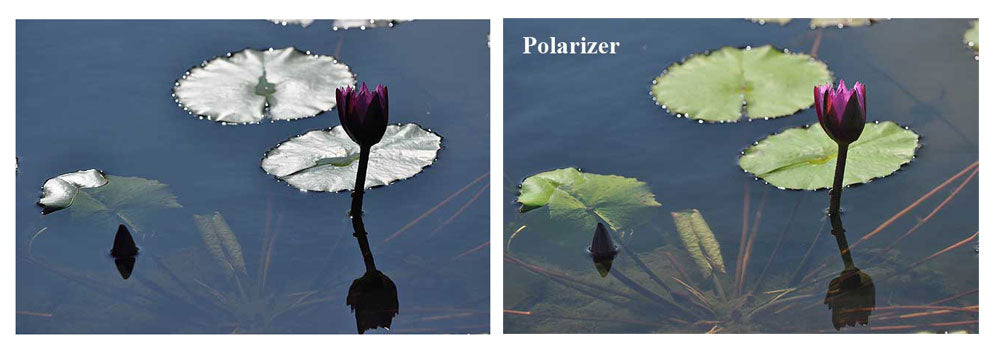Maybe you’ve been taking pictures for a while now and you are starting to wonder why you can’t get your landscape pictures to look like the ones you are seeing online, no matter how much you edit your photographs in Adobe Lightroom or Photoshop. You’ve heard about people using something called a polarizing filter, or, a circular polarizing filter, and you’ve now stumbled upon this article, congratulations! In this article, I will break down for you the many reasons you should and should NOT use a circular polarizing filter. So let’s get right to it!
First, what does a polarizing filter do? Well, if you own a pair of polarized sun glasses, then you already know! Boom, end of article! Ok, but seriously, a circular polarizing filter, or CPL, will effectively cut out reflection. That may sound like a small thing, but it actually impacts A LOT of different areas of your picture in ways that I’d wager you’ve never considered. And that’s not even everything it does! Let’s take a look at all of the ways a CPL will impact your image and break down each way with examples.
-
It will “filter” out reflections. This becomes most obvious when taking landscape pictures with water in the scene, like a lake or river. In fact, in shallow enough water, a CPL will allow you to see right through it revealing all of the rocks and debris under the surface. When photographing water, a common problem is having to deal with glares of light on the water which create distracting highlights. A polarizing filter is the only solution to fix this problem. So, if a CPL will filter out reflections of light on a body of water, then it should do the same with everything that is covered in moisture, right? Right! Are you taking pictures of a stream in the woods? If so, you will see how the CPL not only takes the glare off the water, but it also cuts through the reflected light on the rocks and vegetation, revealing not only greater detail, but also greater (more accurate) color saturation!

Do you not relate to landscape photography? Let me give you another scenario: You are a real-estate photographer taking pictures inside a home that’s about to go up for sale. You notice that you keep getting these annoying reflections on the glass of the windows that are making your pictures look too busy, or maybe they are even showing a reflection of you taking the pictures! Well, a CPL will greatly reduce these reflections as well!
Honestly, if a polarizing filter only did this, I would still consider it magical, but it does much more too! Let’s continue.

- It will add definition to the skies. We have all taken pictures outside where the sky turns into a big white block of nothingness in the background. Unfortunately, this is not an artistic styling of choice, but rather a consequence of our highlights blowing out as though they cared nothing for our composition and subject matter! Well, the best way we can coax those highlights back is with a CPL. A polarizer on our lens in this situation will not only bring definition to the clouds, but it will also darken (deepen) the blues of the sky. So what was once a washed out, uninteresting part of your photograph, now becomes interesting and saturated with information. When you consider that when taking pictures outdoors, the sky is often half of the background of your image, that is a lot of space that we can be creative with, so why not use a circular polarizing filter, and start playing with sky and cloud definition/saturation.
- It will cut out haze. Haze is an often overlooked variable in the creation of a photograph. Haze is a massive issue near big cities with pollution, and getting rid of it will give you a much cleaner and more clear image. If you’ve ever worn glasses, think of it like cleaning your lens- you may not necessarily notice how dirty they are at first, but once they are cleaned, a fuzziness or haze is gone that was once there. Of course, there are other times when haze can create problems too, such as during forest fire season, or even when photographing tall mountains!
-
It will decrease exposure. This normally might be seen as a disadvantage, and don’t get me wrong, it can be if you are taking pictures in a dark forest or ravine, but typically when people are screwing on a polarizing filter, they are taking pictures outside in the sun, and a little bit of of help getting that shutter speed down can be a real advantage, especially when taking pictures of moving water. For example, let’s say you are taking a picture of a small waterfall and you want to communicate the movement of the water. Well, a circular polarizing filter might be just the ticket to allow for a slow enough shutter speed to add a nice smoothing motion blur to the water.

- Can protect front lens element from scratches. This one is pretty self explanatory, but should also not be overlooked. People often buy clear protective filters which are there ONLY to protect your lens, but why not put something on your lens that not only protects it but also provides some real advantages for your images!
So, how is a CPL not awesome? Well, for every action there is a reaction, and now let’s look at each beneficial reason, and see how it can be a negative as well.
- It will “filter” out reflections. Sometimes a picture can look fake if there are not enough reflections for the scene to be believable. Sometimes more information in a picture is not better and can lead to an image looking a bit overproduced, unrealistic, and not balanced. Is there a way around this? Certainly! A circular polarizing filter can be spun around adjusting the effect so that you can find the perfect balance of polarization. What’s so amazing now with mirrorless cameras and their electronic viewfinders is that you can see the varying effects of polarization in real time before the picture is even taken.
- It will add definition to the skies. While we don’t want the sky to be completely washed out without definition and saturation, we also don’t want the sky to be overly saturated as this can appear a bit cartoony and ultimately distracting. We want the sky to be blue, but not too blue. Or simply put, we want the sky to look like the sky. The main problem people run into with polarizing filters is when they use them at full effect. When used maximally, they can create a very dark blue point in the sky with a heavy saturation falloff, meaning the sky may have a very dark section which quickly falls into a very light section. This problem can most easily occur when using a CPL on WIDE ANGLE LENSES. Obviously, the goal is for a relatively even blue, so again just like when filtering out reflections, our goal is for a nice balanced effect, without appearing too heavy handed.
- It will cut out haze. While this would be desirable in some photographs, it may remove a certain “atmosphere” in your picture, if that is the look you are going for. For example, if you are documenting the effects of a forest fire in California, you would most likely want the atmospheric haze that is being created by the smoke. So again, read your scene, and when deciding upon your camera settings, start thinking about how the level of polarization will impact the final image as well.
- It will decrease exposure. A circular polarizing filter will decrease your exposure about 1-2 stops, meaning you will either need to use a slower shutter speed, wider aperture, or higher iso. Either one of these adjustments is usually no problem, but let’s face it, sometimes, it is. You may need the greater depth of field, faster shutter speed, and cleaner image that a lower iso provides. So, while it’s only 1-2 stops of exposure that you are losing, it’s also 1-2 stops of exposure that you are losing!
- Can't always protect front lens element from scratches. While it is very true that a polarizing filter can protect your lens element from scratches, it can also be the cause of a scratch! Let me explain: If a branch or rock or some other thing scratches your polarizing filter, yes, then we can be glad it was there, but, if you drop your lens, there is also a chance of your filter breaking, and THAT broken glass scratching your front lens element. In fact, the glass used in your lens is generally a much higher quality and stronger glass than what will be used in your filter, so this is why some photographers forgo the filter for protective reasons altogether, and only use filters when needed, or in other words, they avoid using filters as a sort of lens cap.
So what should you do? Well, I would strongly recommend a good quality circular polarizer (like this one). You might be thinking, "can’t I make a lot of these corrections in post-production"? And the answer is: well, not really. Yes, you can reduce haze and reflections, and even add saturation and definition to the sky, but never to the degree that a polarizing filter will allow. In post-production, you can only work with the information you have in the “file”, and sure, shooting in RAW instead of JPEG will give you more information to work with, but even then, you will be working with a limited file. I always like to think about the scene as the true “RAW” image, and adjustments you make before taking the picture will ALWAYS create a more refined image than trying to imitate those adjustments afterwards in post-production.
Lastly, not sure which filter size you need for your lens? You can look on your lens for the “mm” needed, or, you can also look at the back of your lens cap, and it usually says it there too.
Ok, that’s all for this article! I hope you found it helpful and I hope I answered all of your questions. That said, if there is something you still aren’t sure of, leave a comment below with your question, or you can always call into the store to speak with one of our staff photographers, who are always more than happy to answer any questions. Ok, now go out and make some beautiful pictures!


